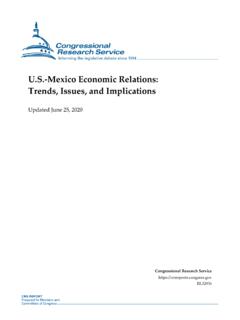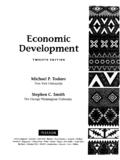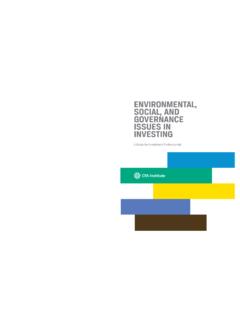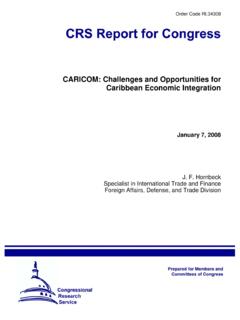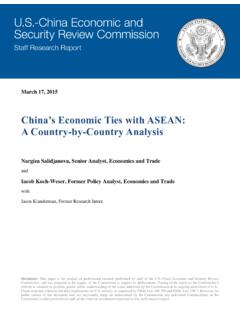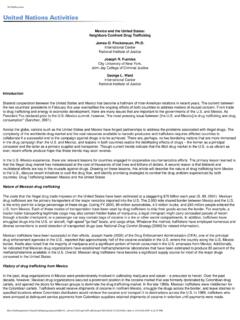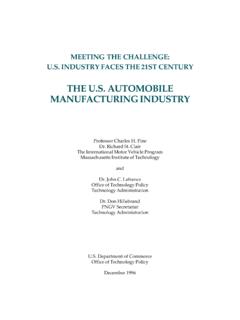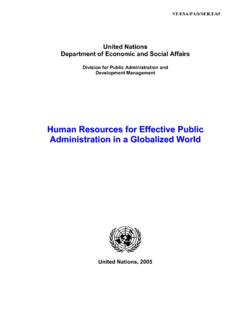Transcription of U.S. Trade Policy: Background and Current Issues
1 Updated September 15, Trade policy : Background and Current IssuesCongress plays a major role in Trade policy through its constitutional authority over tariffs and foreign commerce (Article 1, 8). Since World War II, Trade policy has generally sought to promote economic growth and competitiveness by: (1) reducing global Trade and investment barriers; (2) fostering an open, transparent, and nondiscriminatory rules-based trading system, including through the World Trade Organization (WTO); (3) enforcing partner countries Trade commitments and Trade laws; and (4) offering relief to firms and workers adversely affected by unfair foreign Trade practices and Trade liberalization. Congress has deliberated and legislated in response to aspects of the Trump Administration s Trade policy , including the President s use of unilateral tariffs, the priorities and scope of Trade agreement negotiations, and the approach to China and other trading partners.
2 Economics of Trade economic theory holds that international Trade can be beneficial at the national level, but benefits and costs can be unevenly distributed or concentrated. Countries increase production and export goods and services in which they have a higher relative comparative advantage through skills or resources, and import those unavailable domestically or less efficiently produced. Benefits of Trade can include more efficient resource allocation and greater productivity through competition, economies of scale, higher wages and job growth in exporting industries, as well as greater choice and lower prices for consumers and firms using imports as inputs into final products. Costs can include job, wage, and firm losses through competition from imports and relocation of production.
3 The economic impact of Trade liberalization is difficult to measure and widely debated, in part because other factors influence economic activity, potentially with greater effect, and because expanded Trade may lead to shifts in the composition of economic activity with growth in some sectors and declines in others. Some economists assess that manufacturing employment has been more affected by productivity gains through technological advancements and automation than by expanded Trade . Since 1990, production in the manufacturing sector increased by roughly 60%, while employment fell by one-third. Most economists argue that expanded Trade has been a net benefit to the economy (through the channels described above), but has contributed to job losses in some sectors and regions, including through offshoring, and that workers may require costly retraining or relocation to adjust to the resulting shifts in employment opportunities.
4 Trade Trends The United States is the world s largest economy, trader, and source and destination of foreign direct investment (FDI, stock basis). Trade has expanded (Figure 1) and markets and production have become more integrated, especially with emerging economies. The 2019 top trading partners were Canada, Mexico, China, Japan, and the United Kingdom (UK), and, as a bloc, the European Union (EU-28). The United States has a long-running overall Trade deficit (imports exceed exports); the Trade deficit for goods outweighs the services Trade surplus. Most economists argue macroeconomic variables ( , aggregate savings and investment; valuation of the dollar and its role in global markets) play a larger role in determining the Trade deficit than Trade policies or agreements.
5 Figure 1. Goods and Services Trade Source: Bureau of economic Analysis and Census Bureau. Components of Trade policy Congress sets Trade negotiating objectives, enacts Trade laws, programs, and agreements, and oversees executive Trade functions conducted by a range of federal agencies. By statute, the Trade Representative (USTR) is the lead Trade negotiator and coordinates Trade policy through an interagency process, with formal public and private advisory input. Key policy components include: Trade rules-setting, liberalization, and enforcement. Negotiation of Trade agreements to open markets and set rules on Trade and investment; enforcement of commitments via dispute settlement and Trade laws. Export promotion and controls.
6 Support for export financing, market research, advocacy, and Trade missions; licensing and control of strategic exports. Customs, Trade remedies, Trade adjustment. Regulation of borders; laws to address adverse effects of imports on industries, national security threats, balance of payments, and unfair barriers to exports; assistance for dislocated workers and firms. Trade preferences. Duty-free access to markets for eligible developing countries and products, intended to encourage Trade and spur their economic growth. Investment. Protection and promotion (through investment treaties and Trade agreements); examination of inbound FDI for national security implications. Trade Laws and policy Tools The Administration highlights the Trade deficit as an indicator of foreign unfair Trade practices with potential implications for industry and jobs, and has assertively enforced Trade laws.
7 In particular, the Administration has applied unilateral tariff increases through use of authorities delegated by Congress in the Trade Expansion Act of 1962 (Section 232 tariffs on steel and aluminum) and the Trade Act of 1974 (Section 201 tariffs on washing machines and solar panels, and Section 301 tariffs on Chinese imports). Congress created these authorities to Trade policy : Background and Current Issues address injurious import threats to industry (Sec. 201) and national security (Sec. 232), as well as foreign Trade barriers or Trade commitment violations (Sec. 301). While these tools were used regularly in the 1980s, their use declined following the 1995 creation of the WTO and its enforceable dispute settlement system and removal of certain Trade barriers.
8 Some in Congress question the validity of some of the Administration s tariff actions. trading partners have responded by imposing retaliatory tariffs, negotiating exceptions in the form of quotas or other agreements, and launching WTO complaints. In September, a WTO dispute panel ruled that Sec. 301 tariffs on imports from China violated WTO rules. Trade Promotion Authority Congress and the President generally work together to negotiate and implement Trade agreements. Beginning with the Reciprocal Trade Agreements Act of 1934, Congress delegated limited tariff authority to the President to enter into reciprocal Trade agreements to reduce tariffs within pre-approved levels through proclamation authority. As nontariff Trade barriers grew, Congress adopted fast track authority in the Trade Act of 1974 to provide Trade negotiating objectives and expedited legislative consideration for implementing bills on future Trade agreements while preserving its constitutional prerogatives.
9 Called Trade Promotion Authority (TPA) since 2002, it was renewed in 2015 ( 114-26), and will expire on July 1, 2021. Debate over the renewal of TPA and potential reforms, including to Trade negotiating objectives, may be a focus of the 117th Congress. The World Trade Organization (WTO) The Current rules-based, multilateral trading system is rooted in the WTO, established in 1995 to succeed the General Agreement on Tariffs and Trade (GATT). Formed in 1947, the GATT was part of the post-WWII effort led by the United States and Europe to build a stable, open, and prosperous global economy. WTO core principles include nondiscrimination and transparency, and agreements cover Trade in goods, services, and agriculture; remove tariff and nontariff barriers; and establish rules and disciplines on Issues such as intellectual property rights (IPR) and dispute settlement (DS).
10 Stalled Trade liberalization efforts and Issues such as consensus decisionmaking, developing country exceptions, and noncompliance with notification requirements frustrate some members, leading some to call for or propose reforms. Vexed by perceived overreach in the DS system, the Administration has refused to agree to the naming of new Appellate Body (AB) jurists, which in December 2019, caused the AB to fall below a quorum to hear new cases. This has effectively paralyzed the DS system with new rulings on hold pending appeals. Trade Agreement Negotiations While WTO agreements have stalled, bilateral and regional Trade agreements have proliferated with over 300 in force globally. The United States has 14 free Trade agreements (FTAs) with 20 countries in force, covering market access and rules, usually exceeding WTO commitments.










